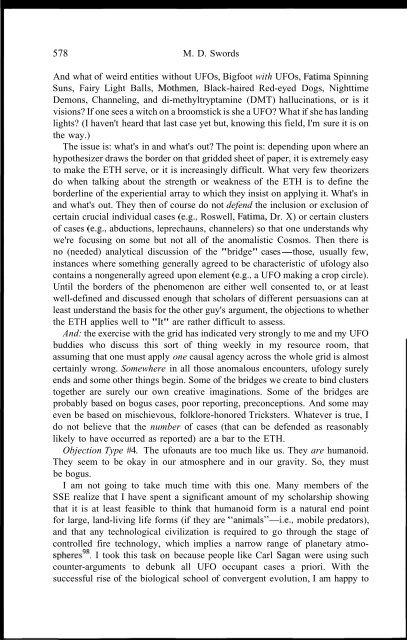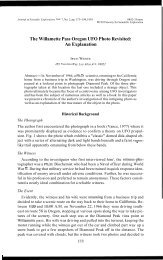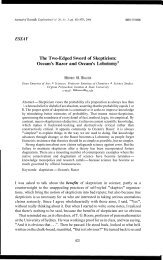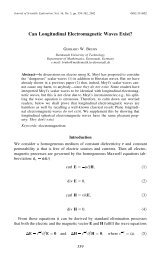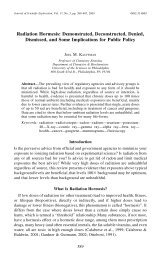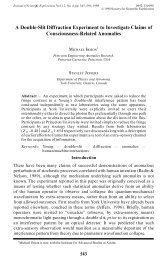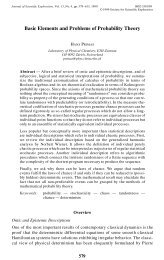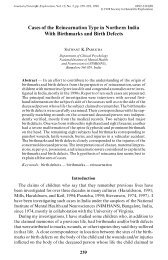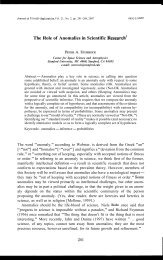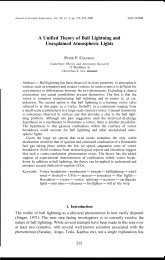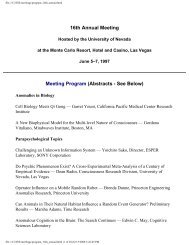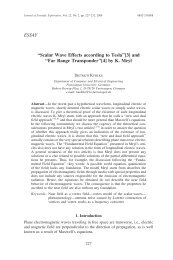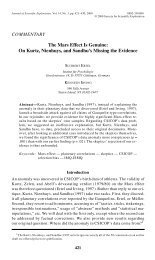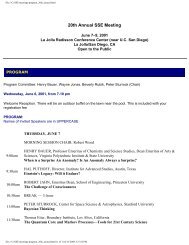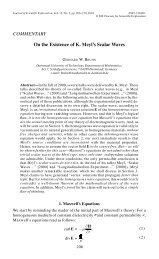REVIEW ARTICLE Ufology: What Have We Learned? - Society for ...
REVIEW ARTICLE Ufology: What Have We Learned? - Society for ...
REVIEW ARTICLE Ufology: What Have We Learned? - Society for ...
Create successful ePaper yourself
Turn your PDF publications into a flip-book with our unique Google optimized e-Paper software.
578 M. D. Swords<br />
And what of weird entities without UFOs, Bigfoot with UFOs, Fatima Spinning<br />
Suns, Fairy Light Balls, Mothmen, Black-haired Red-eyed Dogs, Nighttime<br />
Demons, Channeling, and di-methyltryptamine (DMT) hallucinations, or is it<br />
visions? If one sees a witch on a broomstick is she a UFO? <strong>What</strong> if she has landing<br />
lights? (I haven't heard that last case yet but, knowing this field, I'm sure it is on<br />
the way.)<br />
The issue is: what's in and what's out? The point is: depending upon where an<br />
hypothesizer draws the border on that gridded sheet of paper, it is extremely easy<br />
to make the ETH serve, or it is increasingly difficult. <strong>What</strong> very few theorizers<br />
do when talking about the strength or weakness of the ETH is to define the<br />
borderline of the experiential array to which they insist on applying it. <strong>What</strong>'s in<br />
and what's out. They then of course do not defend the inclusion or exclusion of<br />
certain crucial individual cases (e.g., Roswell, Fatima, Dr. X) or certain clusters<br />
of cases (e.g., abductions, leprechauns, channelers) so that one understands why<br />
we're focusing on some but not all of the anomalistic Cosmos. Then there is<br />
no (needed) analytical discussion of the "bridge" cases-those, usually few,<br />
instances where something generally agreed to be characteristic of ufology also<br />
contains a nongenerally agreed upon element (e.g., a UFO making a crop circle).<br />
Until the borders of the phenomenon are either well consented to, or at least<br />
well-defined and discussed enough that scholars of different persuasions can at<br />
least understand the basis <strong>for</strong> the other guy's argument, the objections to whether<br />
the ETH applies well to "It" are rather difficult to assess.<br />
And: the exercise with the grid has indicated very strongly to me and my UFO<br />
buddies who discuss this sort of thing weekly in my resource room, that<br />
assuming that one must apply one causal agency across the whole grid is almost<br />
certainly wrong. Somewhere in all those anomalous encounters, ufology surely<br />
ends and some other things begin. Some of the bridges we create to bind clusters<br />
together are surely our own creative imaginations. Some of the bridges are<br />
probably based on bogus cases, poor reporting, preconceptions. And some may<br />
even be based on mischievous, folklore-honored Tricksters. <strong>What</strong>ever is true, I<br />
do not believe that the number of cases (that can be defended as reasonably<br />
likely to have occurred as reported) are a bar to the ETH.<br />
Objection Type #4. The ufonauts are too much like us. They are humanoid.<br />
They seem to be okay in our atmosphere and in our gravity. So, they must<br />
be bogus.<br />
I am not going to take much time with this one. Many members of the<br />
SSE realize that I have spent a significant amount of my scholarship showing<br />
that it is at least feasible to think that humanoid <strong>for</strong>m is a natural end point<br />
<strong>for</strong> large, land-living life <strong>for</strong>ms (if they are "animals"-i.e., mobile predators),<br />
and that any technological civilization is required to go through the stage of<br />
controlled fire technology, which implies a narrow range of planetary atmospheres98.<br />
I took this task on because people like Carl Sagan were using such<br />
counter-arguments to debunk all UFO occupant cases a priori. With the<br />
successful rise of the biological school of convergent evolution, I am happy to


